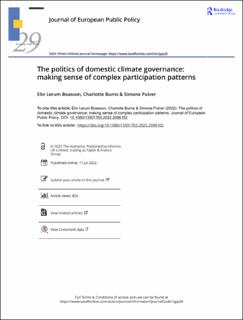| dc.contributor.author | Boasson, Elin Lerum | |
| dc.contributor.author | Burns, Charlotte | |
| dc.contributor.author | Pulver, Simone | |
| dc.date.accessioned | 2024-02-06T12:31:24Z | |
| dc.date.available | 2024-02-06T12:31:24Z | |
| dc.date.created | 2022-08-26T09:36:57Z | |
| dc.date.issued | 2022 | |
| dc.identifier.citation | Journal of European Public Policy. 2022, . | en_US |
| dc.identifier.issn | 1350-1763 | |
| dc.identifier.uri | https://hdl.handle.net/11250/3115921 | |
| dc.description.abstract | This article reviews literature on six actor groups engaged in domestic mitigation governance. It evaluates the usefulness of three climate governance models: market failure, socio-technological transition and public support. For each group, three modes of action are considered: influencing, decision-making and implementing. The public support model is found to best capture the wide range of actors and real-world, complex participation patterns of domestic climate governance. The socio-technological transitions and market failure models in their narrow focus on political and business actors ignore the influencing roles of other groups, such as climate advocacy organizations, anti-climate action groups, Indigenous people’s organizations and labor unions. However, they offer more insight on actor engagement in decision-making and implementation, roles mostly ignored by the public support model. Overall, more systematic comparative research is needed on a wider range of actors, on domestic climate governance in the global South, on differences across countries, sectors and policy domains and on interactions between actors. | en_US |
| dc.language.iso | eng | en_US |
| dc.rights | Navngivelse 4.0 Internasjonal | * |
| dc.rights.uri | http://creativecommons.org/licenses/by/4.0/deed.no | * |
| dc.title | The politics of domestic climate governance: making sense of complex participation patterns | en_US |
| dc.title.alternative | The politics of domestic climate governance: making sense of complex participation patterns | en_US |
| dc.type | Peer reviewed | en_US |
| dc.type | Journal article | en_US |
| dc.description.version | publishedVersion | en_US |
| dc.source.pagenumber | 0 | en_US |
| dc.source.journal | Journal of European Public Policy | en_US |
| dc.identifier.doi | 10.1080/13501763.2022.2096102 | |
| dc.identifier.cristin | 2046215 | |
| cristin.ispublished | true | |
| cristin.fulltext | original | |
| cristin.qualitycode | 2 | |

